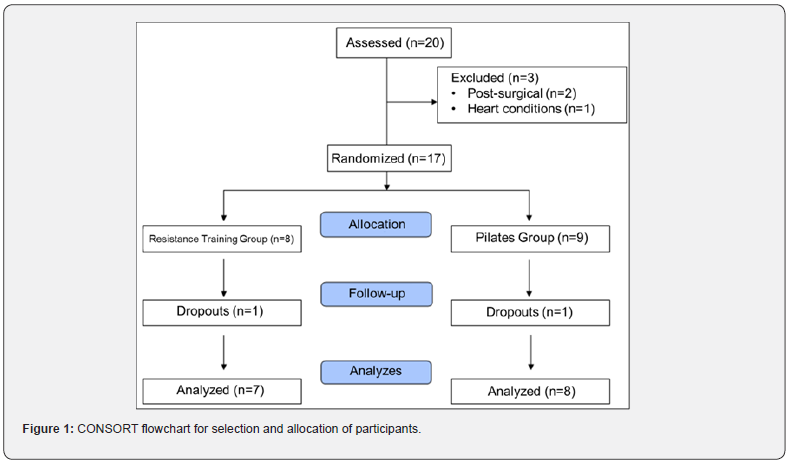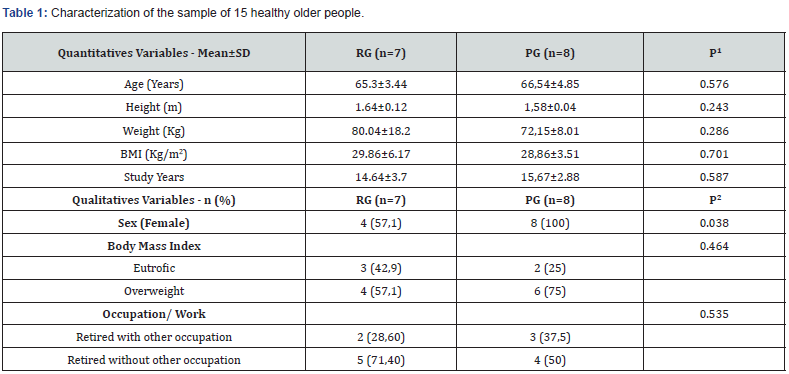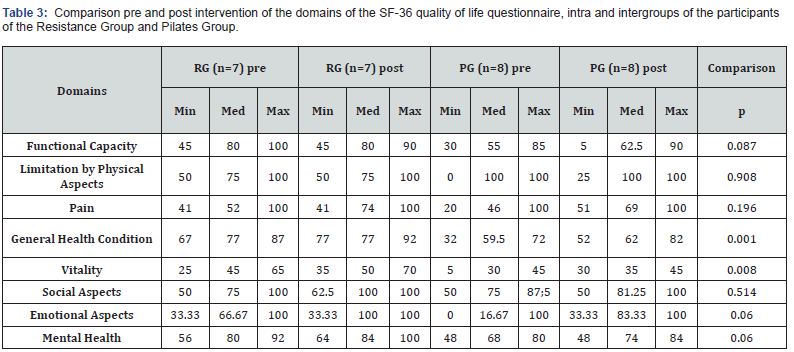Yoga and Physiotherapy - Juniper Publishers
Abstract
Objectives: The study aimed to compare the effect of different exercise modalities on dynamic balance, physical capacity, and quality of life. Methods: Fifteen older people aged over 60 years participated in this randomized clinical trial. Group 1 performed resistance training (RG) and Group 2 exercises based on the Pilates method (PG). The dynamic balance behavior was evaluated by Timed Up and Go (TUG) and the 6-minute walk test (6MWT) physical capacity. Quality of life was assessed using the questionnaire SF-36. Results: Regarding balance and physical capacity, we can observe an improvement in the results of TUG and 6MWT, after four weeks of intervention in the PG. No significant differences were found when comparing STG and PG. In terms of quality of life, the criteria of general health and vitality had a statistically significant improvement in the STG and PG. It is concluded that for the older people evaluated in 4 weeks of training, there was no statistically significant difference compared to the groups for the dynamic balance and physical capacity variables. Both strength exercises and Pilates method show significant improvement in criteria assessed in quality of life.
Keywords: Aging; Postural Balance; Physical Capacity; Quality of Life; Physical Training
Abbreviation: RG: Resistance Training, PG: Pilates method, TUG: Timed Up and Go, MWT: Minute Walk Test, UFCSPA: University of Health Sciences of Porto Alegre, SPSS: Statistical Package for Social Science
Background
Physical changes due to the aging process affect muscle strength, balance, and gait, leading to a decline in physical capacity in older people, increasing the chances of falls, morbidity, and mortality among this population [1]. Physical exercise is an intervention used by health professionals for muscle strengthening, physical resistance, and prevention of changes in body balance in the older population. With the practice of exercise, it is possible to obtain an improvement in the risk factors of chronic degenerative diseases, gait speed, muscle weakness, consequently improving the biopsychosocial domains and increasing the quality of life [2,3].
Resistance training has been one of the most common exercise programs applied to the older people, and it has been established that this type of training improves muscle strength, range of motion, levels of functional autonomy, body composition and mental health [4-6].
Among the physical activities recommended for this public, the Pilates method also stands out, which portrays a system of physical exercises created by Joseph Pilates more than a century ago and, even with its multiple ramifications, it is noted that the work with the method is based on the wide variety of movements combined with proper breathing [2,3,5,7,8]. This study is justified by the fact that the literature indicates resistance training and the Pilates method as excellent exercise options for the older people [3,7], however, is not known which of the two has a greater effect on balance, physical capacity, and quality of life in healthy older people, and there is still a lack of standardization in exercise protocols. Therefore, the objective of the present study was to analyze the effect of two different training programs (resistance training versus Pilates method) on the dynamic balance, physical capacity, and quality of life of healthy older people in the community.
Methods
Blinded randomized controlled clinical trial. Approved by the Research Ethics Committee of the Federal University of Health Sciences of Porto Alegre (UFCSPA), under number 2.137.840/2017. Fifteen older people participated in the study, 7 in the Resistance Training group (RG) and 8 in the Mat Pilates group (PG). All volunteers who agreed to participate in the research signed the Informed Consent Form.
Subjects
Older people, residents in the city of Porto Alegre, who were contacted through different sources participated in this study: public invitation, carried out through posters; dissemination on social networks and local dissemination actions with pamphlets. Inclusion criteria were people aged 60 years or older, as established by Brazilian Law No. 8.842 [9], with available time for training. Those who had autonomy and independence, and control of chronic diseases and physical symptoms were considered healthy [10]. Older people who were in a regular physical training program in the last 12 weeks, cognitively impaired, people with a physical disability that prevented them from participating in the groups, in any type of postoperative period or at high risk for performing physical exercises, by cardiopulmonary, vascular, or metabolic disorder, were excluded.
Procedures for Data Collection and Evaluations
The evaluation of the participants was carried out by the same evaluator before and after the training. In the first evaluation, the Mini-Mental exam was performed [11] to assess the individual’s cognitive ability to participate in the study. Dynamic balance was assessed by Timed Up and Go (TUG) test. The test indicates balance and functional mobility, whose performance is related to gait, postural and direction changes during the act of walking, being evaluated through the time spent in carrying out the route [12]. The physical performance was assessed using the Six-Minute Walk Test (6MWT), which measures the maximum distance covered in a period of 6 minutes and is commonly used to assess submaximal cardiorespiratory capacity while performing activities that require commuting. [13]. All individuals were familiarized with the tests previously.
To assess quality of life, participants answered the Medical Outcomes Study 36 - Item Short-Form Health Survey (SF-36) [14] seated in a comfortable and air-conditioned environment.
Intervention Protocol
To ensure the quality of the intervention protocol, as well as the method used in this study, the teams responsible for the training protocols were trained by the responsible researcher to perform the exercises specifically in the RG or PG groups. The study was conducted in secrecy about the training method, focusing on protocol criteria and the safety of participants. The individuals were randomized into two groups, RG and PG, with a training frequency of 3 times a week, over 4 weeks, lasting 60 minutes each. The older people in the RG were first submitted to the estimated test of one repetition maximum (1RM estimated), following the recommendations of the ACSM [15], for each of the exercises of each training cycle. All loads were then adjusted to 70% to 80% of 1RM [15,16]. The protocol was composed of 12 global exercises. The individuals were instructed to perform three sets, from eight to twelve repetitions in each. If the participant reported that the load was light, the load was adjusted again.
In the PG, the protocol had 24 global exercises, all maintaining the principles of the Pilates method. The method is based on 6 principles: control, breathing, fluid movement, precision, concentration, and centering [17]. The exercises were performed with sets of ten repetitions [18]. All exercises were performed on the ground, without the use of equipment. Only accessories such as a Swiss ball, soft ball, stick, dumbbell (1 kg for all individuals) and elastic band were used. [19]. In all sessions, of both groups, the individual was submitted to the same training model, with the same exercises, and if the individual needed any adaptation for the exercise, this was done. In this study, in both training programs, exercises involving strengthening of upper and lower limbs, abdominal and trunk muscles were designed, each modality respecting the characteristics described above. There was a rest period between one exercise and another, not exceeding the time of 1 minute. If the participant reported exhaustion to perform the task, it was finished. No more than 4 individuals were allowed per training schedule, with 2 duly trained instructors to carry out the protocol.
Allocation Sequence Generation
The division between the RG and PG groups occurred after the initial evaluation under analysis of the inclusion and exclusion criteria, following the availability of volunteers’ participation. A table was presented to the older people with the training times, without identifying the modality at each time. According to his availability for training, he stayed in G1 or G2 and only learned the type of training when he participated in it, although the researchers responsible for the training were careful not to mention which method was being used. The health professional who carried out the initial assessment of the elderly was unaware of the schedules for each group, therefore, there was no influence or indication during the choice of the individuals. Both RG and PG offered morning and afternoon schedules, and alternated offering weekly schedules for the beginners. The person responsible for this logistics also kept the assessments confidential for the researchers who conducted the training sessions.
Allocation Masking and Implementation
The evaluators were not aware of the RG and PG training schedules. The researchers responsible for the training were blinded to the evaluation process and to the opposite group. The volunteers were instructed not to comment with the evaluators during the reassessment about the types of exercises they performed. The researcher responsible for analyzing the outcomes was not aware of the allocation of groups, receiving data from the evaluator as Group 1 and Group 2.
Blinding
Due to the masking and implementation of the allocation, the volunteers, the evaluator, the researchers responsible for the training and the researcher responsible for the analysis of the outcomes were blinded.
Statistical Analysis
For data analysis, the Shapiro-Wilk test was performed in order to verify the normality of continuous data. The descriptive analysis of parametric numeric data was expressed as mean and standard deviation, and when non-parametric as median, minimum, and maximum. Descriptions of qualitative variables were expressed in absolute and relative frequency. For inferential analysis, comparisons between RG and PG referring to baseline data were performed using the Student’s t test for independent samples when continuous, and the Chi-square test with Yates correction when categorical. To compare the non-parametric data of the SF-36, the Kruskal Wallis H test and the post hoc Mann Whitney U test were used. Comparisons between GF and GP in the TUG and 6MWT, for the 2 groups in the 2 moments, before and after, were carried out with the Anova Two-Way test with Sheffee’s Post-hoc. All analysis was performed using the Software Statistical Package for Social Science (SPSS, version 21), considering a significance level of 5% (p≤ 0.05).
Results
The present study was composed of 7 individuals in the RG and 8 in the PG. All showed cognitive ability assessed by Mini Mental to participate in the study. The allocation of participants is shown in Figure 1. The characterization of the elderly is presented in (Table 1). There were no differences between the groups in the evaluated variables, demonstrating a homogeneity of the sample, except for the number of female individuals in the GP. The results referring to the applied tests are presented in (Table 2). All the participants were able to complete the dynamic balance and physical capacity tests without interruptions. Regarding the quality of life of the participants, assessed by the SF-36 questionnaire, we can highlight an improvement in the domain of vitality (p=0.008) and general health status (p=0.001) even with statistical significance (Table 3).


Where: SD= standard deviation; n= sample; %= relative sample; RG= resistance group; PG= Pilates group; BMI= body mass index; p¹= Student’s t test to independents sample; p²= Qui-Square test with Yates correction.

Where: n= sample; RG= resistance group; PG= Pilates group; SD= standard deviation; 6MWT= six-minute walk test; p= comparison by Anova Two-Way with Shaffee Post-hoc.

Where: n= sample; RG= resistance group; PG= Pilates group; Min= minimum; Max= Maximum; Med= Median; p= H of Kruskal Wallis with Mann Whitney’s U post hoc.
Discussion
In the present study, we did not observe a statistically significant improvement in relation to the performance in the TUG test, corroborating the findings of Vieira et al [19]. One of their hypotheses would be the intervention duration. In addition, we also believe in the hypothesis that they are healthy elderly people, who already had values considered good for their age group in the initial assessment, and another assessment instrument could provide greater specificity to the results. However, the TUG is the most used instrument to assess balance in the older people [17]. The RG did not show improvements in balance after the intervention period, still demonstrating a decline in its performance. The findings of Low et al [6] e Orr et al [20] claim that resistance training does not generate changes in variables on balance. In order to obtain results on balance in the older people, more dynamic and challenging exercises are recommended, with resistance training indicated as a complement to intervention on this outcome. Because, since balance is dependent on several systems for its maintenance, one should not work on resistance exercises alone [21].
We can observe the improvement in TUG results in relation to the effect on balance in elderly people in PG compared to RG, although not statistically significant. Exercises based on the Pilates method, in general, include dynamic muscle stretching and muscle strengthening using body weight as resistance. [22]. According to Chatzopoulos et al [23] dynamic stretching has a positive effect on balance, unlike static stretching. This being one of the hypotheses that would explain the change in the behavior of equilibrium in RG. Also, studies from Barker et al [24], Bullo et al [25] and Cancela et al [26] concluded that the Pilates method has strong evidence of improvement in static and dynamic balance in older people. Research demonstrate that the Pilates method activates and strengthens the central musculature of the “power house”, required during the execution of the exercises and this can contribute to an improvement in the posture and alignment of the trunk, changing the center of gravity, which directly reflects on the maintenance capacity of body balance [27,28]. Regarding physical capacity, we can observe a greater distance in the 6MWT after four weeks of intervention in the RG, although the comparison between RG and PG reached statistical significance (p=0.06). In exercises based on the Pilates method, planti and dorsiflexors and lower limb strength are worked on simultaneously throughout the exercises [29]. What may have contributed to a better performance in the 6MWT, suggesting that individuals have a more evident improvement in physical capacity with training based on the Pilates Method [18].
According to Santos et al [30], exercises that work on motor coordination are able to provide an increase in gait speed in the older people, also indicating functional independence [31]. Comparing the Pilates method to traditional resistance exercise, it presents a greater degree of difficulty in its execution, since it requires concentration, activation, and coordination of several muscle groups at the same time [22]. In both groups, the SF-36 domains on vitality and general health showed improvements, indicating the positive impact that physical exercise provides in the lives of the elderly. With age-related physical losses, the older people have a reduction in physical activity levels and become more sedentary, reduce their work and social activities, factors that may be associated with a decrease in quality of life [32]. In addition to the health benefits of regular physical activity, seniors find support from other seniors in these groups and end up resuming their social activities. Therefore, physical exercise brings significant changes to the quality of life of older people [32-34].
Existing studies regarding the effect of training on balance in older people have been described in systematic reviews and meta-analyses as having low methodological quality. Which demonstrates the importance of carrying out works encompassing this theme [35,36]. In this study, we evaluated healthy older people. In addition, the average age of the participants demonstrates that they are young older, which could justify the values presented in the TUG in the initial evaluation. According to Alcock et al [37] the postural control of older women suffers worsening with age, with significant annual reductions, with greater oscillation in the most challenging conditions. The number of individuals in this study was a limitation, data collection was terminated early due to the onset of the Covid-19 pandemic. During the study five participants did not stay over the four weeks. It is known that the older population has difficulty in following an activity, mainly due to family commitments, health problems, lack of social and family support [32]. New studies are suggested with larger samples, and with longer duration protocols, in order to identify from what moment, the gains on balance occur. Second Bird [38] to obtain improvements in balance attributed to neuromuscular adaptations, at least 5 weeks of training are required.
Conclusion
The findings of this research showed that in four weeks of training, there was no statistically significant difference compared to the groups for the dynamic balance and physical capacity variables. Both strength exercises and the Pilates method show significant improvement in criteria evaluated in quality of life, which is extremely relevant, showing that, regardless of the time of performance, these modalities bring benefits to healthy older people./p>
To Know more about Journal of Yoga and Physiotherapy
Click here: https://juniperpublishers.com/jyp/index.php
To Know more about our Juniper Publishers
Click here: https://juniperpublishers.com/index.php





No comments:
Post a Comment